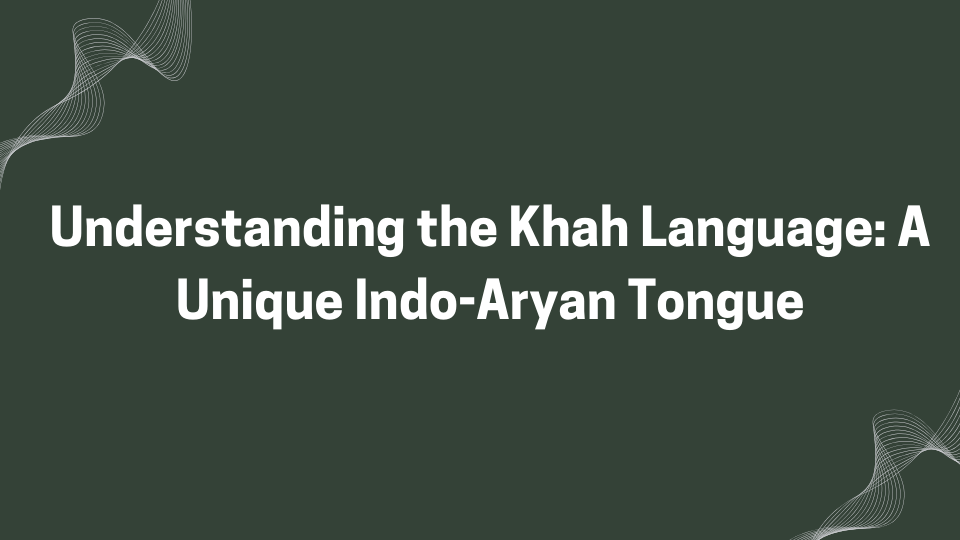Khah Language Overview
Khah (کھاہ), also known as Khasha or Khashah (کھاشاہ), is an ancient language belonging to the North Western Pahari subgroup of the Indo-Aryan languages. It is primarily spoken by approximately 200,000 speakers in the Ramban district of Jammu and Kashmir, India. Additionally, Khah is found in neighboring districts such as Reasi, Udhampur, Doda, Rajouri, Anantnag, and Baramulla.
Geographic Distribution and Demographics
The Khah language has a rich geographical presence, with most speakers located in Ramban. Other areas where Khah is spoken include Chenani, Busht (Udhampur), Lar (Reasi), Kishtwar, Jammu, Halsidar (Anantnag), Srinagar, and Rajouri. Beyond India, Khah speakers can also be found in Pakistan, the USA, and Saudi Arabia. Despite its significance, Khah is often confused with other languages, such as Poguli, Khana, and Khashali.
While the official language of Jammu and Kashmir is Urdu, Khah is one of the lesser-known languages of the region. It coexists with other recognized languages, including Kashmiri and Dogri, both of which are part of India’s 22 scheduled languages. Unfortunately, Khah is not widely taught in schools, and many speakers often use Urdu, Kashmiri, Dogri, or English as their second language.
Language Family and Characteristics
Khah is classified under the Indo-European language family, specifically within the Indo-Iranian and Indo-Aryan branches. It has its own unique features, including two primary word orders: verb-second (V2) and verb-final. The language utilizes both Perso-Arabic and Devanagari scripts, with the former being more common for contemporary writing.
Phonology of Khah
Khah features a diverse array of vowel and consonant phonemes, enriching its sound system. The vowels include:
- Front Vowels: i, iː
- Central Vowels: ə, əː
- Back Vowels: u, uː, o, oː, a, aː, ɔ, ɔː
Khah’s consonant inventory includes stops, fricatives, affricates, trills, flaps, laterals, and nasals, making it a phonetically rich language.
Archaic Elements
Khah preserves several archaic features that date back to early Indo-Aryan languages. For example, the number ‘two’ retains the original prefix ‘dva-‘ in Khah, unlike many other Indo-Aryan languages, which use ‘ba-‘ or ‘bi-.’
Notably, certain phonetic shifts, such as /s/ becoming /h/, parallel changes observed in Vedic Sanskrit, indicating Khah’s deep historical roots.
Grammar and Structure
Khah grammar exhibits characteristics typical of Indo-Aryan languages, including inflection based on gender, number, and case. The gender system is divided into masculine, feminine, and neuter categories, with specific rules governing noun formation.
Noun Declension
Khah nouns decline according to four cases: nominative, dative, ergative, and vocative, expressed through suffixation.
Verbal Conjugation
Khah verbs are conjugated based on tense, aspect, and person, showcasing a rich inflectional system. The present tense is formed using an auxiliary construction combined with the imperfective suffix. The language also features a distinct system for the simple past and future tenses, demonstrating its grammatical complexity.
Preservation Efforts
As globalization increases, languages like Khah are at risk of fading. However, local communities are committed to preserving Khah through educational initiatives and cultural events. Efforts to teach Khah in schools and create written records aim to maintain its usage among younger generations.
Conclusion
The Khah language is an essential part of the cultural identity of the people in Ramban and surrounding regions. Its preservation is vital for maintaining the rich heritage of the Khasha community. Understanding Khah not only connects speakers to their roots but also contributes to the broader tapestry of India’s linguistic diversity.

